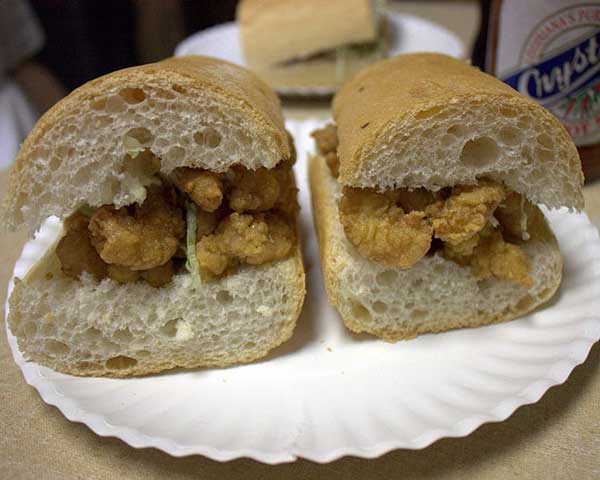The Food Almanac: Thursday, September 12, 2013
Today's Flavor
Today is Fried Shrimp Day. Even though, to my palate, frying is a) the most boring way to cook shrimp and b) one of the most boring dishes of any kind out there. But I am out of the mainstream in believing this, so forget I said it.
Still, let's look at these things. Seems to me the batter ought to be on the light side, that the shrimp ought to be in the range of medium (25 to 35 count to the pound), and (of course) that they be fresh, Louisiana wild-caught shrimp. That last qualification is not merely cheering for the home team. We really do have the world's best shrimp here, and although you can spend less on the farm-raised Asian shrimp that have taken over local supermarkets, you pay for it in flavor.
The coatings used for basic fried shrimp fall in four categories. The most common is seasoned flour, with corn meal or corn flour (or a mix of the two) being next most popular. A certain number of shrimp fryers prefer bread crumbs; this works particularly well if the shrimp are large and butterflied, so they come out more or less panneed. Finally there's tempura, the Japanese style of coating the shrimp in a batter made with flour and eggs. It gets puffy when it fries. (Eaters tend to either love or hate that last style.)
Fried shrimp can go beyond the basic, and that's when they begin to hold my interest. They can be coated with the likes of pulverized nuts or coconut or even a semi-stuffing made of crabmeat or tasso mixed with cornmeal. Or wrapped with a piece of bacon, which also hold in place a wad of peppery cheese. Many such are served with a sauce, usually with a sweet-savory aspect.
There's one more issue as regards fried shrimp: why do most restaurants in the upscale category believe that leaving the tail on makes them more valuable? Answer: it's all for looks.
The Old Kitchen Sage Sez
If you have some really nice, big, fresh shrimp, and you fry them, I'm going to come over and hit you over the head with a black iron skillet until you see the light.
Gourmet Gazetteer
Shrimp Creek flows into the Ogeechee River about thirty-five miles northwest of Savannah, Georgia. It's a meandering, sluggish little stream through the woods that separate large tracts of corn farms. If you find yourself there and hungry (chances are not good for finding any but the tiniest shrimp in there), slog over to Guyton, four miles away, and put your elbows on the counter at Claudette's Country Kitchen.
Eating Around The World
Today is National Revolution Day in Ethiopia, recalling the overthrow in 1974 of Emperor Haile Selassie. Although the thought of Ethiopia usually brings up the image of starvation in the minds of Americans, the cuisine of that country and its neighbor Eritrea is interesting enough that it's very popular in the cities where it's taken hold. Washington, D.C., for example, has dozens and perhaps hundreds of Ethiopian places. At this time New Orleans has none, although we've had a couple Ethiopian restaurants in the past. To make a long story short, the cuisine has aspects of Middle Eastern and Indian food, with many unique aspects as well. A flat bread called injera is used to scoop up the thick stews. Ethiopian eating is distinctive as it is ancient.
Music To Make Toast By
Today in 1964, a one-hit wonder band called the Newbeats had a Number Three hit with a song called Bread And Butter. "I like bread and butter," it said, "I like toast and jam. That's what my baby feeds me. I'm her lovin' man." The lyrics go on to make a pretty obvious sexual double entendre, but apparently we were too innocent in those days to believe that's what they meant.
Edible Dictionary
saffron, n.–Part of the dried stigmas of the crocus flower, used as an aromatic spice that lends a yellow-orange color to foods. It's most famously used in bouillabaisse (and all the other soup-stews like it), as well in paella. Its use as a spice originated in ancient Persia, but it reached its full expression in Kashmir. The most famous and expensive saffron now comes from Spain. It takes an acre of crocuses–700,000 flowers–to make ten pounds of saffron. The stigmas must be removed by hand. So it's expensive–running neck-and-neck with white truffles for the distinction of being the most expensive food ingredient in the world. The best saffron comes in threads an inch long. Cheaper saffron can be bought, particularly in open markets in the Middle East, but its flavor and coloring properties are much inferior.
Food Namesakes
Mathematician Haskell Brooks Curry was born today in 1900. . . American League Most Valuable Player in 1943, Spud Chandler, was born today in 1909. . . Rap singer Bizzy Bone was born today in 1976. . . Writer James Frey opened The Big Book today in 1969.
Words To Eat By
"Never eat Chinese food in Oklahoma."–Bryan Miller, former restaurant critic for the New York Times.
Words To Drink By
"A German wine label is one of the things life's too short for, a daunting testimony to that peculiar nation's love of detail and organization."–Kingsley Amis, author of Everyday Drinking
